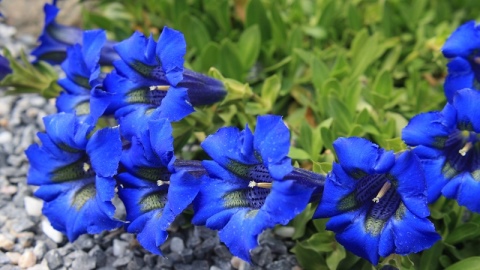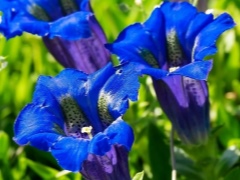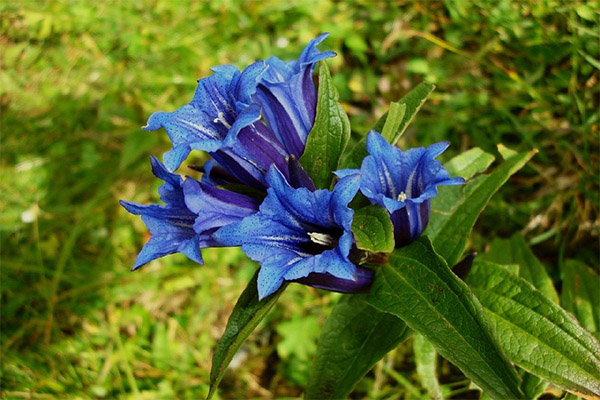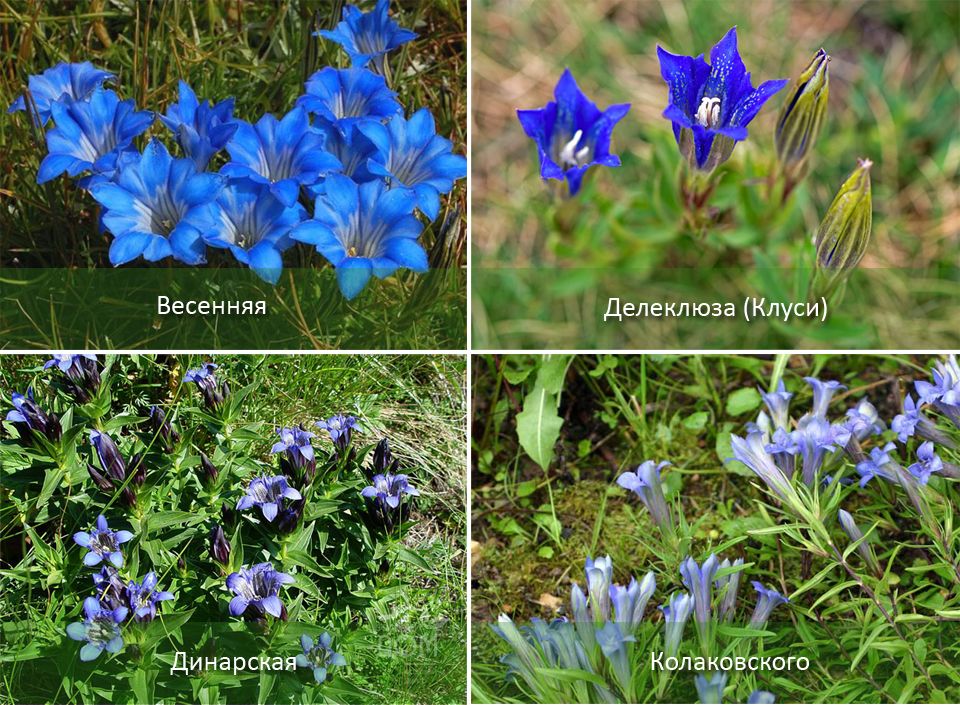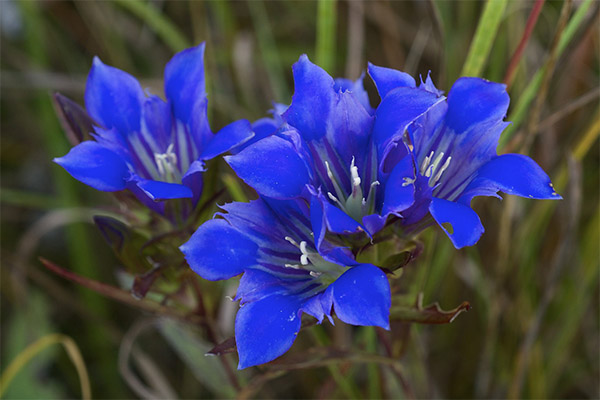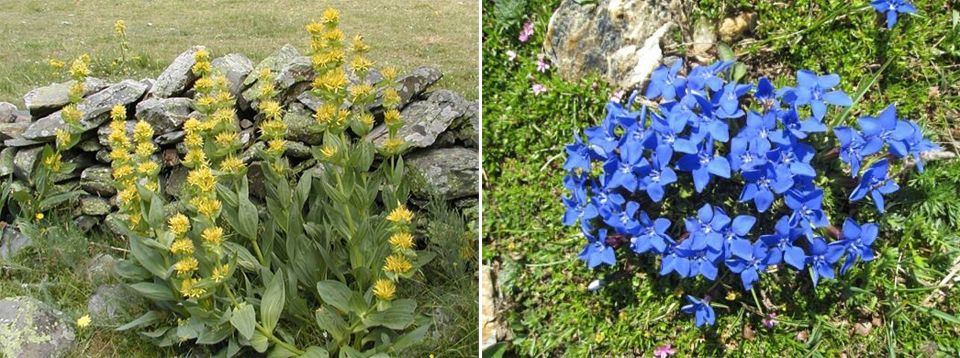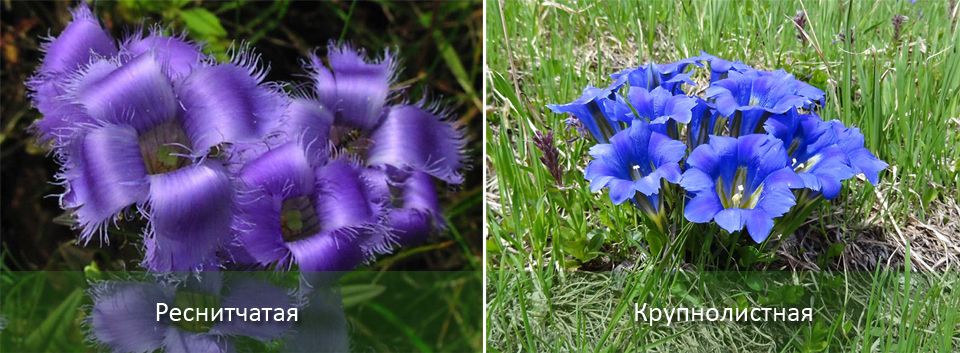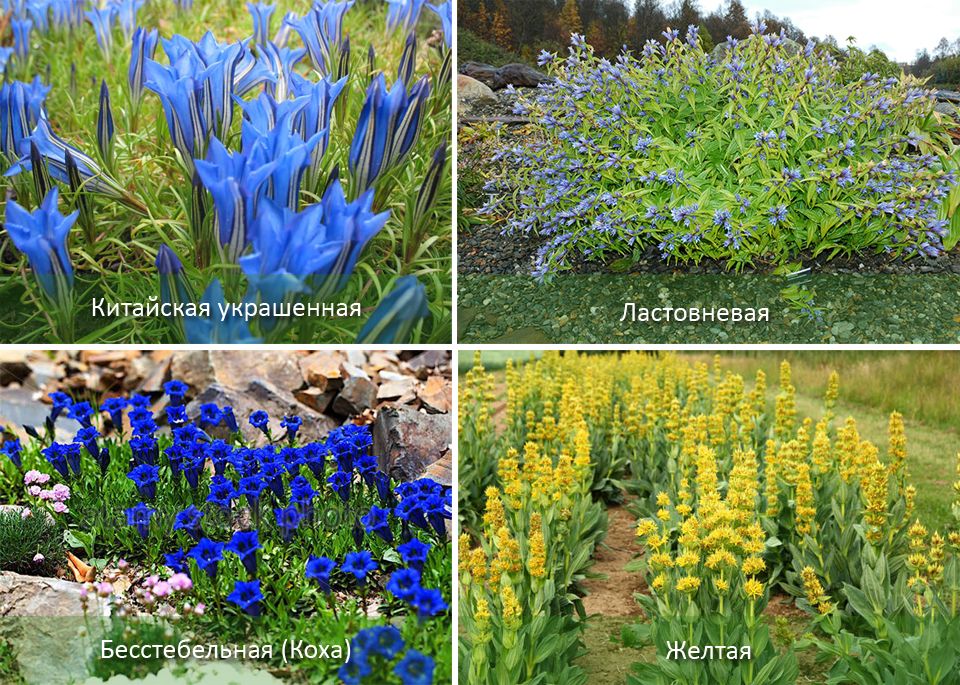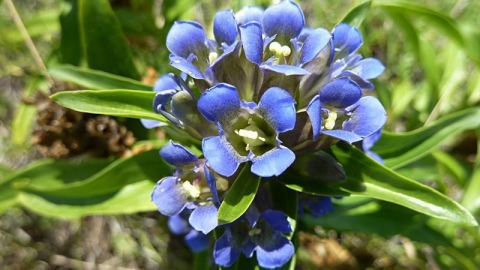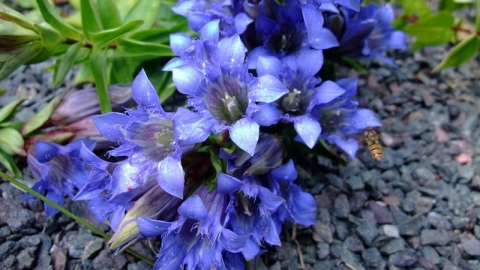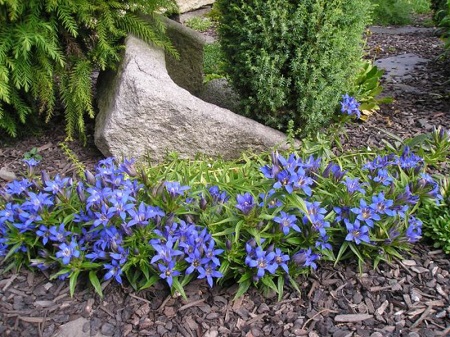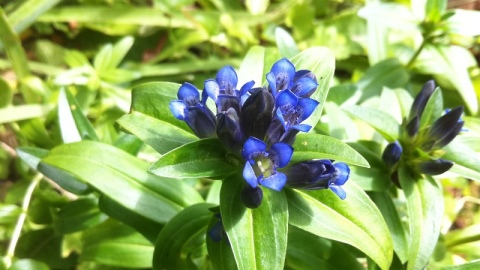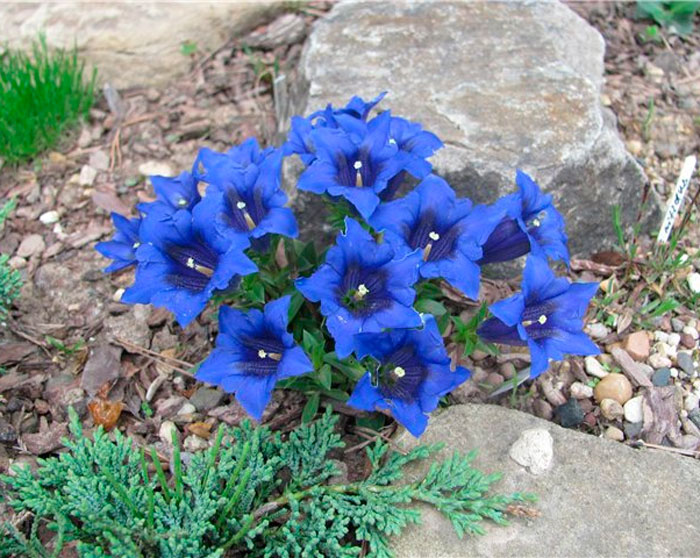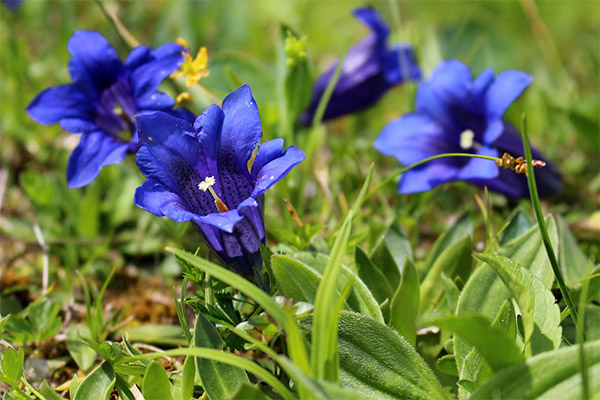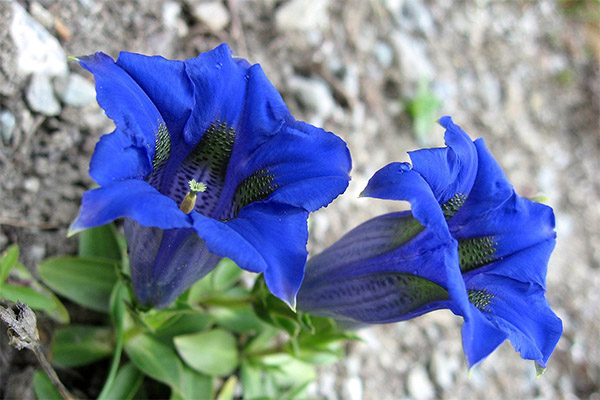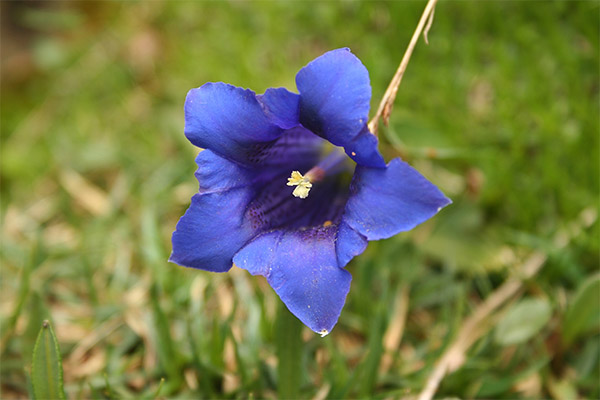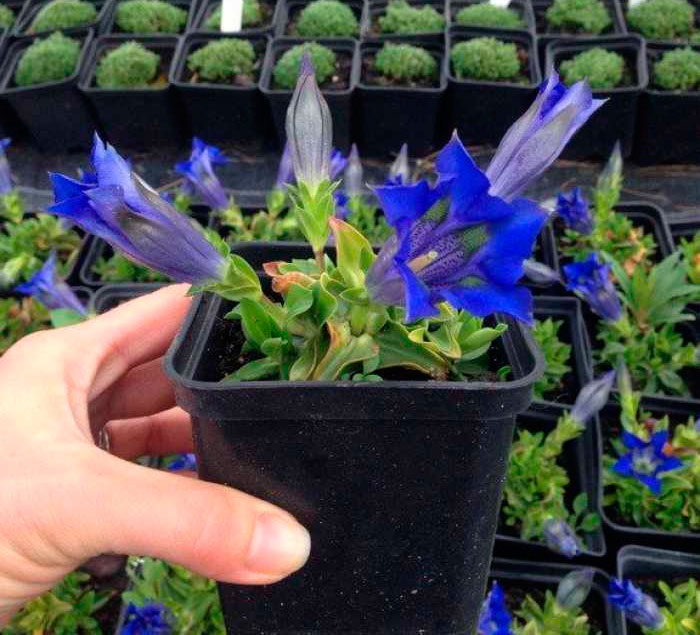Varieties and varieties
The gentian family has more than 400 varieties and varieties. This diversity is due to the fact that flowers grow on different continents and are forced to adapt to different climatic conditions. For home cultivation, you can choose any of the varieties - it will not be difficult to provide the color with comfortable conditions.
Common gentian (pulmonary)
The pulmonary gentian is a short plant that can grow up to 50-60 cm in height. It grows in open meadows and plains and tolerates frost well. The flowers are single, bright blue or light blue. The shrub needs abundant watering, in nature it often grows in swampy areas.
Gentian yellow
The yellow gentian is one of the largest varieties, it can grow up to 1.5 m. Differs in unusual flowering - individual flowers in complex inflorescences. They are colored bright yellow and appear in the second half of summer. In the photo, the yellow gentian looks bright and impressive.
Gentian cruciform
Cross-leaved gentian (cruciform) belongs to the late varieties. It has a straight, strong stem up to 50 cm in length, densely covered with green leaves. The flowering period begins in the second half or late summer. The cruciform gentian can be recognized by the characteristic color of the petals - they have a turquoise, purple or purple hue.
Dahurian gentian
Daurian gentian is also one of the medium varieties that blooms in the second half of summer. Unlike other varieties, its stem is not strong enough, but it can reach 50 cm or more. Tall shrubs may have shoots that are located on the ground. The leaves are pale green. The flowers are single, large, and have a bright blue color.
Gentian
Gusset gentian is a late variety. Its stems are tall, straight, and can grow up to 80 cm with proper care and maintenance. In nature, it begins to bloom at the end of summer, and period of its flowering affects early September. The variety has an unusual petal shape. They are pointed, can be blue with a purple tint, or be completely white.
Large-leaved gentian
Large-leaved gentian is a short plant, its largest representatives grow up to 70 cm. The name is explained by unusual leaves. They are narrow and located at the base of the plant and in internodes, each can be up to 20 cm long. Single inflorescences are elongated and have a characteristic shape. Petals reach 2 cm in length, inflorescences practically do not open. The main stem is strong, the additional shoots can be soft and fall down to the ground. Flowering occurs in summer.
Koch gentian
The stemless gentian (Kokha) grows naturally in mountainous regions. Its stem practically does not rise above the ground and can reach a maximum of 15 cm. The variety belongs to the early ones. Abundant flowering begins in early May and can last until mid-June. Inflorescences are small, have a deep blue tint. This variety is well suited for creating a living carpet in the local area.
Seven-part gentian
Seven-part gentian is one of the most unpretentious varieties. It adapts to any climatic conditions, easily tolerates frost. The inflorescences are blue with a slight lilac tint. The plant begins to bloom at the end of June.
Spring gentian
Spring gentian belongs to the early varieties. It does not reach large sizes - the average shrub grows only 10-15 cm. Flowering begins early, the first inflorescences appear in the middle or late spring, when the air temperature stops dropping at night.The flowers are small, colored blue or blue, and may have a purple hue.
Diseases and pests of gentian
Diseases of gentian and their treatment
Outdoors, gentians can get sick with gray or basal rot, leaf spot, rust, and some viral diseases. Of all fungal diseases, gray rot is the least controllable, and viral diseases are, in principle, incurable.
Gray rot - This disease can be recognized by the rapidly growing gray-brown spots that appear during periods of high humidity. As the disease progresses, gray mold forms on the spots. The affected plant areas should be immediately removed with a sharp sterile instrument, capturing healthy tissue, after which the wounds should be treated with Fundazole solution. To prevent the development of gray mold, dusting or spraying plants with fungicides is used.
Most often, gray rot develops in too dense plantings in which air circulates poorly.
 In the photo: Growing gentian in the garden
In the photo: Growing gentian in the garden
Spotting is also fungal in nature and appears on the leaves of the plant in small yellowish-brown heels with a purple rim. They destroy the pathogens of spotting with copper-containing preparations, for example, Bordeaux mixture, copper sulfate or more modern fungicidal agents.
Rust is caused by fungi that are highly resistant to chemicals. You can find out that the gentian was struck by this particular disease by the dark brown pustules formed on the leaves of the plant, in which the spores of the fungus mature. Affected plant areas should be removed and burned immediately, but never put into compost. At the first sign of rust, treat the area with a fungicidal solution.
Basal rot most often affects Asian gentian species, which bloom in the fall: as a result of the development of infection in conditions of high humidity during the seedling period, the base of the stem rot in plants. To protect seedlings from condensation drops and prevent disease development, place plastic wrap or glass at a slight angle. As an effective preventive measure, dusting of the basal part of gentian with Tsineb is used.
Gentian pests and the fight against them
Gentian pests can be annoyed by thrips, slugs, snails, ants, caterpillars and nematodes.
Slugs and snails eat gentian leaves and buds, greatly reducing the level of its decorative effect. It is good if their natural antagonists live on your site - toads and hedgehogs. But if these animals are not in your garden, you will have to set traps for mollusks: lay potatoes cut in half across the area or dig in cans up to the very neck, filled with beer or fermented compote by a third of the volume.
The ants in the gentian area are not so much harmful as they are annoying, and as soon as your patience comes to an end, apply an insecticidal preparation against them, which can be purchased at a specialized store.
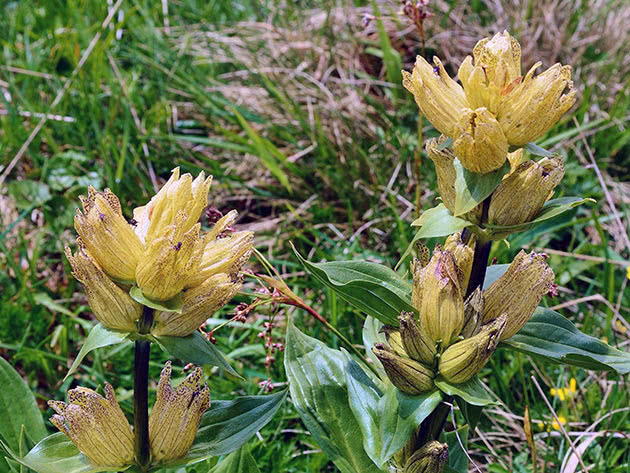 In the photo: How to grow gentian outdoors
In the photo: How to grow gentian outdoors
Thrips are small sucking insects that reproduce more actively in the warm season. They feed on the cell sap of plants, leaving small discolored spots in the bite. Thrips are destroyed with insecticidal preparations.
Caterpillars are dangerous for young shoots and germinating seeds. The fight against them is carried out with the help of insecticides, which are used to treat the area with gentian several times at intervals 10 days.
Nematodes can be detected only by the result of their destructive activity: slight deformation of the apical leaves, retardation of plant growth and development, curvature of its stems. You can get rid of pests by treating gentian three times with a special nematode preparation, which can be purchased at a garden pavilion or store.
Conditions comfortable for autumn gentian
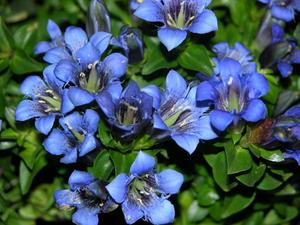 Photos of these plants can delight any grower.However, you can also admire them live, if their characteristics are taken into account when growing. These plants are unpretentious, so they can be grown in almost any conditions. Although, within the framework of this genus, plants can be distinguished that can feel good only on soils with a certain acidity and dryness. At the same time, they all have common requirements.
Photos of these plants can delight any grower.However, you can also admire them live, if their characteristics are taken into account when growing. These plants are unpretentious, so they can be grown in almost any conditions. Although, within the framework of this genus, plants can be distinguished that can feel good only on soils with a certain acidity and dryness. At the same time, they all have common requirements.
Considering the decorative properties of autumn yellow gentians, they look effective as a decoration for alpine slides. However, their inclusion in dry expositions is not always the right choice. It is recommended to post them on the western or, at least, on the east side, where temperatures are lower. Any plant grows poorly under the scorching rays of the sun, on nutrient-poor soils. In cases where it is difficult for you to find a suitable place for this plant, it is recommended to plant it in places where there is partial shade.
- Decorated Chinese gentian. This plant needs good lighting during the growing season, which lasts all summer and autumn. In spring, she feels good in partial shade, so this kind of gentian is usually planted next to spring bulbs. The fact is that at the time of the withering away of the last gentian, it becomes possible for a large amount of light to enter;
- Farrer's gentian. This plant can grow well even in shade conditions. When growing other species, it is necessary to choose the right neighbors for them. It is best to combine them with cereals and spring bulbs, which create a slight shade at the beginning of the year.
In the process of selecting a place for plants, it is necessary to take into account not only the illumination, but also the humidity of the air. Autumn gentian grows best when planted in humid areas. Therefore, the most optimal areas for them will be areas near water bodies - streams, ponds or fountains. Planting yellow gentian is recommended in ordinary garden soil.
Decorated gentian has its own cultivation characteristics, which is recommended to be planted in moist, acidic soil that has drainage and a loose structure. In this case, the soil must be sufficiently moist.
Ciliated gentian grows best on calcareous soils and places where relatively low air humidity is maintained. All other species of these plants are independent of acidity. In general terms of soil texture, many species do well in loose, light, nutrient-rich soils. Drainage must be present, the soil must be well permeable.
Planting
When preparing the holes for planting autumn yellow gentians, fill them with gravel drainage. Moreover, they must be large - for this you need to proceed from the volume of the earthen lump of seedlings, which they must exceed by 3 times. Plants must be placed no closer than 15-30 cm from each other.
Useful properties of gentian

Medicinal properties of gentian
The gentian is a real storehouse of healing properties. For this reason, the shrub is in great demand both in folk and official medicine. Due to the presence of glycosides in tissues, the culture is famous for its effective pharmacological action. Glycosides stimulate appetite, improve the functioning of the digestive system and suppress spasms.
Along with glycosides, the tissues contain alkaloids. They are able to stop seizures and lower body temperature, so gentian is often used as an anti-inflammatory and sedative. The roots contain resinous and tannins, oils, pectins, sugars, acids, and inulin. The underground parts of the plant are rich in phenol carboxylic acids, which increase the permeability of the gastrointestinal tract and improve intestinal function.
Gentian preparations are prescribed for diseases of the upper respiratory tract, anemia, diathesis, heartburn, cancers, malaria and chronic forms of hepatitis.
The medicinal properties of gentian are recognized by official medicine. Today, a number of medical institutions produce tinctures and extracts of yellow gentian. Many herbal preparations consist of this raw material. In folk medicine, the herb is successfully used externally and internally.
A decoction of the leaves cures sweating in the legs. Purulent cuts dry out a powder made from chamomile and gentian roots. Herbal compresses from a grated mushy mass relieve pain in muscles and joints. For the preparation of medicinal gruel, vegetative parts and roots are used.
Folk recipes from gentian

Let us dwell in more detail on the most useful recipes that will come to the rescue and will have a beneficial healing effect on the body as a whole.
- To improve appetite. You will need to take 1 tbsp. chopped dried roots and cover them with a glass of water. After boiling, the container with grass is left on the stove for another 10 minutes, then cooled and passed through cheesecloth or a sieve. The strained broth must be taken in 1 tbsp. before meals.
- From the disease of rheumatism and arthritis. For the preparation of the broth 3 tbsp. the dried raw material is diluted in 700 ml of water. The mixture is boiled for 15 minutes and insisted for a couple of hours. Half a glass of the finished broth should be drunk before each meal.
- For the treatment of tuberculosis, malaria, unhealthy digestion, heartburn and constipation. It is recommended to use an alcoholic extract of gentian. 50 g of dry grass is poured with vodka in an amount of 500 ml. It is better to use a bottle for storing tincture with dark glass, then the fermentation processes will proceed much faster. It is sealed tightly and left in a cool room without access to light for 7 days. Then filter the tincture and drink 30 drops every day.
Contraindications
Gentian preparations can cause allergic reactions in people with individual intolerance to the components. Such plant materials are dangerous for stomach and duodenal ulcers, as well as with increased pressure. Pregnant women should not take such drugs, since the substances in the herb and bitterness can negatively affect the development of the fetus and the general well-being of the mother. For medicinal purposes, it is allowed to drink no more than 35 drops of tincture per day. Such a norm is quite acceptable for an adult body. In case of an overdose of the drug, a person experiences severe dizziness, headaches, and the face becomes covered with red spots.
Gentians grown from seeds

Garden flowers Perennial flowers Annual and biennial flowers
Types and varieties of gentian
In ornamental gardening, annual gentians are rarely used, while perennial representatives of this genus are very popular. We offer you an acquaintance with the most popular species, varieties and hybrids of this plant.
Stemless gentian (Gentiana acaulis)
Or gentian Koch (Ciminalis acaulis = Gentiana excisa = Gentiana kochiana) - in nature, this winter-hardy herbaceous perennial is found in the mountains of Western Europe. It has stems up to 10 cm high, oval-elongated green leaves with which the plant meets winter, and large, upward-facing blue or blue flowers up to 5 cm long, blooming in May-June. This species has the alba species with white flowers.
In the photo: Stemless gentian (Gentiana acaulis)
Gourd gentian (Gentiana asclepiadea)
Or cotton wool - perennial up to 80 cm with pointed oblong-oval leaves up to 10 cm and straight peduncles height up to 5 cm, on which 1-3 blue or dark blue, and sometimes white flowers are formed.
In the photo: Gourd gentian (Gentiana asclepiadea)
Dahurian gentian (Gentiana dahurica)
The species is native to the Sayan Mountains, Mongolia, Dauria and Tibet.Its stems are up to 40 cm high, straight or ascending. Basal leaves, narrowed at both ends, have a linear-lanceolate shape. The stem leaves have a short sheath, while the upper ones have almost none. This is a blue gentian: large flowers located in the axils of the upper leaves are painted in an intense dark blue hue. The Daurian gentian has been cultivated since 1815. It is grown both for cutting and as a container plant.
In the photo: Dahurian gentian (Gentiana dahurica)
Yellow gentian (Gentiana lutea)
It grows wild in Asia Minor and Central Europe, being one of the tallest types of culture: in height the plant can reach one and a half meters... It has a taproot, the lower leaves are large, petiolate, oval-elliptical, and the stems are much smaller. Numerous yellow flowers up to 2.5 cm long form in the axils of the upper leaves and at the tops of the stems. Flowering begins in mid-summer and lasts one and a half to two months. In culture, this cold-resistant species, wintering without shelter, since 1597.
In the photo: Yellow gentian (Gentiana lutea)
It has a wide growing area: China, Mongolia, the Far East, Central Asia, Eastern and Western Siberia. It has erect or straight stems up to 70 cm in height and 3-6 mm in diameter. The bases of the stems are 2-8 cm shrouded in fibrous remnants of old leaves.
In the photo: Large-leaved gentian (Gentiana macrophylla)
Pulmonary gentian (Gentiana pneumonanthe)
Growing in Europe and Asia, it has erect unbranched, densely leafy stems up to 65 cm high, lanceolate-linear leaves up to 6 cm long and up to 6 mm wide and forms dark blue flowers with a bell-shaped calyx and a tubular-club-shaped corolla at the top of the stems and in the axils of the leaves.
Photo: Pulmonary gentian (Gentiana pneumonanthe)
Seven-part gentian (Gentiana septemfida)
Grows wild in Asia Minor, Iran, Crimea, the European part of Russia and the Caucasus. The plant reaches a height of 30 cm, it has numerous erect or ascending stems covered with lanceolate leaves, and dark blue flowers up to 4 cm long, collected in heads. In culture, the gentian is seven-part since 1804.
In the photo: Gentiana septemfida
In addition to the species described, in the culture you can also find spring gentians, Delecluse (or Clusi), Dinaric, Kolakovsky, Chinese decorated, large-flowered, ciliate, frosty, dotted, three-flowered, narrow-leaved and rough.
Recently, thanks to the work of breeders, many hybrid forms of gentian have appeared, which are highly decorative. Of these, the most interesting are:
- Gentian Nikita - a plant with many azure-blue flowers of medium size;
- Bernardi is a plant blooming in August with partially tubular dark azure flowers;
- Dark Blue is an autumn variety with bright ultramarine flowers, decorated with dark stripes on the inside of the petals;
- Blue Emperor is a dwarf variety with ultramarine flowers;
- Farorna is a hybrid variety with pale blue flowers and a creamy white corolla;
- Gloriosa is a Swiss variety with wide-open blue flowers with a snow-white throat;
- Elizabeth Brand is a hybrid with elongated azure flowers and short brownish stems.
Gentian care
If the gentian was sown on a plot that suits her perfectly, then when growing it, the gardener should have absolutely no problems. When the seedlings appear, they need to ensure timely watering and loosening of the soil surface, and weeds need to be removed from the site in time.
If such a plant is grown for decorative purposes, then it will be necessary to remove dried flowers in a timely manner, which will preserve its decorative effect. If the coming winter should be snowy and frosty, then the area where the gentian grows will need to be covered with a layer of spruce branches.
How to water and feed
Such a plant is moisture-loving, therefore it is necessary that the soil on the site is constantly slightly damp. In this regard, it must be watered systematically, while using a sufficient amount of water.It especially needs watering during a prolonged dry period, during the setting of buds or the opening of flowers. When the bed is watered, its surface near the plants must be carefully loosened, while pulling out all existing weeds. In order to reduce the number of watering, weeding and dressing, the surface of the site must be covered with a layer of mulch, which is used as organic material (straw, sawdust or peat).
You do not need to feed such a herbaceous plant, especially if at the beginning of spring you mulch the area with peat, which is pre-mixed with horn flour and limestone.
Description of culture
Of the common features characteristic of all varieties of gentian, it can be noted that it is a herbaceous plant. Its stems are straight, with oblong leaves growing opposite, and the roots are short and thick. This is where the similarities end. Further characteristics depend on the species of the flower. It can be either a miniature annual dwarf shrub up to 10 cm in height, or a lush perennial bush up to 1.5 m in height.
The gentian bloom is very spectacular and bright, but also determined by the species. There are early flowering, summer and late varieties, which allows you to create a flower bed only from this culture, blooming all season. The flowers themselves in most species are bell-shaped, and in some they look like a round plate.
But gentian seeds, regardless of the species, are always small, enclosed in a bivalve box.
Diseases and pests of gentian with photos and names
Diseases
When grown in open soil, gentians can be affected by basal or gray rot, rust, leaf spot and some viral diseases. It is most difficult to cure gentian from gray rot in comparison with other fungal diseases. And to date, an effective cure has not yet been found for viral diseases, so diseased bushes must be dug up and burned as soon as possible so that the virus does not spread further.
Gray rot
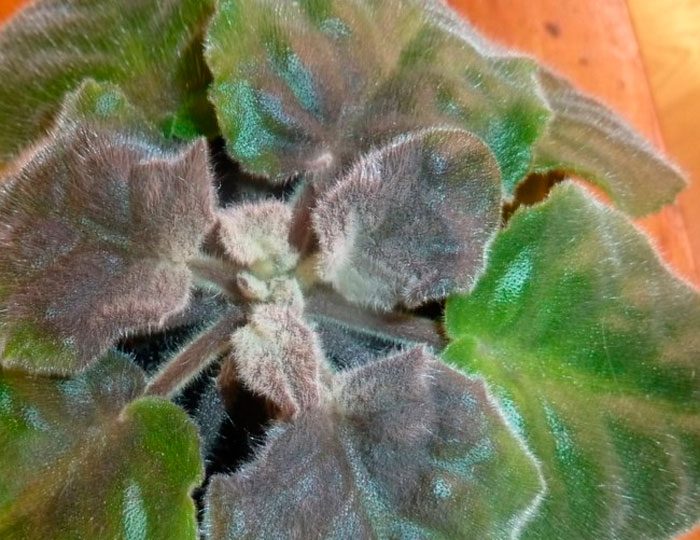
If the bush is affected by gray rot, then spots of a brownish-gray color appear on its surface, which very quickly increase in size. The development of the disease is observed with increased air humidity. Over time, gray mold appears on the surface of the stains. Infected parts of the bush must be cut out as soon as possible, using a very sharp instrument that has been disinfected in advance, while it is imperative to grab healthy tissue. Then carry out a thorough treatment of wounds with a solution of Fundazole. In order to prevent the bushes, it is recommended to spray or dust with fungicidal preparations. Most often, such a disease affects gentian when plantings are thickened, since there is very poor air circulation in them.
Brown spot
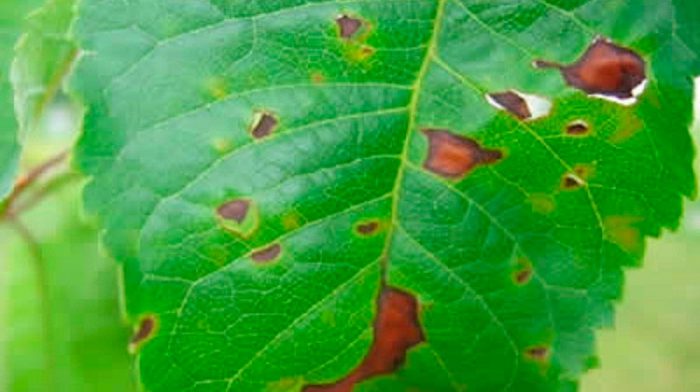
Spotting is also a fungal disease. In the affected plant, small brownish-yellow specks appear on the foliage, which have purple rims. They must be sprayed with products containing copper, for example, you can use copper sulfate, Bordeaux liquid or other fungicides of a similar action.
Rust

Rust is caused by fungi resistant to chemicals. In a diseased plant, pustules of a dark brown color appear on the leaf plates, and spores of the fungus ripen inside them. Infected parts of the bush are cut out and must be destroyed; they cannot be put into compost. After diseased bushes are seen on the site, all other plants must be sprayed with a fungicidal preparation.
Basal rot is most often affected by Asian species of such a plant, which bloom in autumn. As the disease progresses in conditions of high humidity, rot on the base of the stems of gentian seedlings appears.For prevention purposes, young plants need to be protected from condensation drops; for this, the shelter (glass or film) is placed at a not very large angle. And also in order to protect the seedlings from such a disease, the basal part of the plants is powdered with Tsineba.
Pests
Thrips, slugs, snails, ants, caterpillars and nematodes can settle on the gentian. Slugs and snails noticeably reduce the decorative effect of the bushes, nibbling the buds and leaf plates. If there are hedgehogs and toads on the site (natural antagonists of gastropods), then this will be very good. If they are not there, then traps will need to be made. To do this, potatoes are placed on the surface of the site in several places, which must be pre-cut into 2 parts, instead, you can take cans and bury them in the ground up to 1/3 of the neck, pour fermented compote or beer into them.
Ants do not harm this culture, but not all gardeners are pleased to see them on their site. If such a need arises, then you can get rid of them with a special insecticidal preparation, which is freely sold in a specialized store.
Thrips
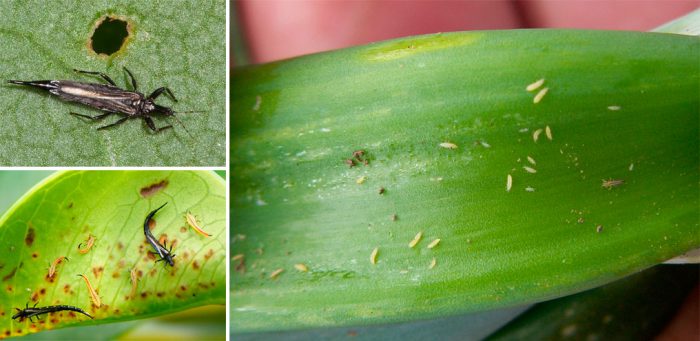
Thrips are small sucking insects, their most active reproduction is observed in the warm season. Such insects suck out cell sap from the gentian, while in those parts of the bush where there are punctures, small discolored dots appear. To destroy thrips, you need to use an insecticidal solution.
Caterpillars
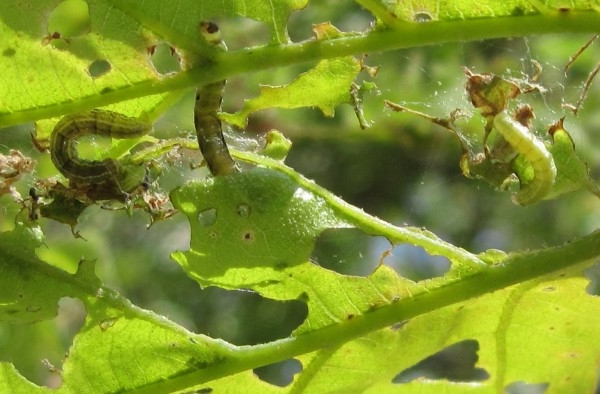
Caterpillars pose the greatest danger to germinating seeds and young seedlings. They also get rid of them with the help of insecticidal preparations, while it is necessary to spray the area with them every 1.5 weeks.
Nematodes

The fact that nematodes have settled on the gentian can only be understood by the results of their activity: the apical leaf plates of the bushes are slightly deformed, their development and growth are delayed, the shoots are noticeably bent. To destroy such a pest, the bushes must be sprayed 3 times with a special anti-nematode agent, it can be purchased at a specialized store.
Gentian in the garden
The gentian is good on rocky areas and in rockeries. This is how she looks the most natural. It is advisable to use group plantings, then a solid carpet will cover the allotted area. It will delight you with sapphire shades, which are rarely found in nature.
In the flower garden, tall plants are used in central positions, and undersized species are used in the foreground. Blooming or ornamental plants should be placed next to them, which do not grow too much. It can be sage, sedge, bells. You can plant gentian in front of coniferous and deciduous shrubs. The neighborhood with medium-sized cereals is also effective.

